 Kent Coast Sea Fishing Compendium |
Saltwater Swim Feeders |
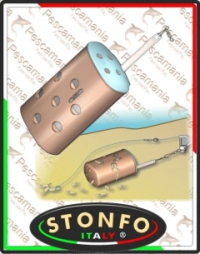 |
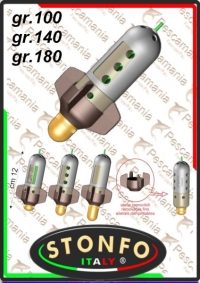 |
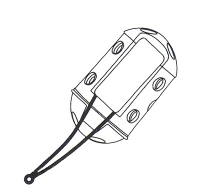 |
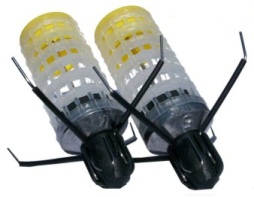 |
Swim feeders are a simple modification to add to end rigs, but offer big advantages in increasing the overall catch, targeting individual species and, when bites are scarce, having a strong scent trail wafting downtide can pull in fish to your bit of beach and make a huge difference to the catch rate. Most species respond to swim feeder fishing including bass, eels, flounders, dabs, whiting, rays and dogfish.
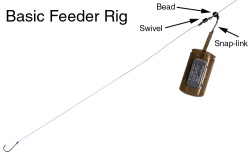
Ideally, a feeder that will fit on the long tail of a lead is best. By placing the feeder on the tail of the lead good casting performance is retained as the feeder travels in the air pocket broken by the lead and the combined weight of the loaded feeder and lead travel as one giving a clean cast. Having the eyes at each end means you can connect the feeder to the base of any normal rig using an oval split ring. A second split ring attached to the feeder's bottom eye takes the lead weight. This is the best option for close range fishing.
A general rule is to choose a slow release feeder during the strongest tide run, then go for a larger holed canister as the tide drops back to slack water.
Fishing a feeder works especially well inside estuaries when after flounders and eels. By placing each cast within the same area you set up a feeding station that draws fish from far and wide, but more importantly, holds them there. Try it off the open beaches at close range. The added scent in the water pulls in dabs, whiting, flounders, school bass, pout, dogfish and coalfish. At long range, especially into deep water over sand, you stand a much better chance of taking rays if you've a feeder quadrupling the amount of scent your bait is putting down. Rays are lazy and only follow up fresh, strong smells. Weak scents to a ray mean that the food is probably a long way off and may already have been eaten by other fish.
Using feeders over rough ground emphasises their effectiveness. A fish based mix really makes lazy conger take notice. By fishing a feeder and casting to the same spot each time again and again, the ground bait and small fish activity can make reluctant-to-move conger eels leave their holes and work their way in to feed.
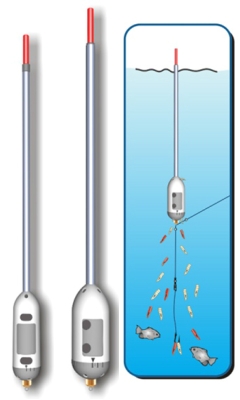
Feeders also increase your chances of huss and dogfish over the same ground:
- a simple, but very effective mix for all fish is minced mackerel with a little pilchard oil added, then mixed with animal feed bran to make a thick, stodgy mix. This works well on rough ground fish like conger and huss, and rays over sand;
- a good bait for dogfish is tinned cat food mixed with small amounts of bran;
- when using crab baits for bass and flounders, take off the leftover bait from the hook and push this into the can. Not all the juice will have washed out and this, plus a freshener of peeled crab legs, adds enough scent to the water to attract searching fish;
- to target whiting, cut fresh or frozen chunks of mackerel and herring and add them loosely to the can so that the sea water washes both scent and small pieces of flesh free;
- crab chunks and shelled mussels make good feeder additives when fished close for winter coalfish;
- the best feeder fillers are standard fishmeal and herring meal mixes mixed stiff, sometimes with old bread as extra binder, with a little mackerel oil for added scent;
- bits of chopped up mackerel, peeler crab, lugworm and mussel also work, but must be chopped finely or put through an old food blender.
Feeders work best in conjunction with long hook snoods e.g. around 24 inches, and one down, one up rigs that keep the hook-baits close to the feeder. Use hook-baits that are juicy and different to that presented in the feeder as the objective is to enable the fish to identify the hook-bait scent amongst the feeder smell. In calm clear water, adding bright red colouring to the feeder mix increases the catch rate. Sight must also play a part.
The best way to carry feeder ingredients is by pre-mixing them at home and carrying them either fresh, or frozen in sealed plastic bags. You don't need much for a session. Work on four casts per hour, that's 16 casts for four hours, so carrying something the size of a 1lb sugar bag should get you through.
"Swim Feeders" Youtube video uploaded by StealthCroft on 31 August 2009
"Sea Fishing" (1964) Harvey Torbett at page 56
One form of groundbaiting which has caught the imagination of British anglers is that involving the use of pilchard oil, which is used to flavour baits before use. The notion is that, as the oil washes off it provides a scent trail leading to the bait. A tackle-dealer friend of mine recommends the use of an ordinary "swim-feeder" as used in freshwater fishing. The plan is to fill the tube with cotton wool which has been well soaked in pilchard oil. This is attached by a sliding link to the end of the trace, being stopped a foot or so above the bait. It certainly provides a lasting scent trail, although it is possible for the quarry to be attracted to the feeder-tube rather than to the bait, and seize this instead.
"The Art of Sea Angling" (1966) T. Housby at pages 135 & 136
Another excellent mullet attractor developed for use in sea water is the "exploding swim feeder". This is a device used mainly by fresh-water leger anglers and consists of a perforated Perspex tube to which a lead keel has been added. Into the tube is pushed a quantity of ground bait. To make the feeder work properly it is essential to do this carefully in the following manner: first a wad or wedge of damp bran ground bait is pushed into the end of the tube - this should fill up approximately one quarter of the "feeder" - then a quantity of dry ground bait should be added, leaving just enough space for a further wedge of damp bran … mixed in … a strong solution of water and pilchard oil. This oil, of course, is an added fish attractant …
… Use the swim feeder as a weight, the baited hook being attached approximately 15 inches above the feeder so that, technically, the tackle is rigged as a conventional one hook nylon paternoster.
The whole idea of mixing the ground bait in the manner described is so that, once the feeder has been immersed in the water for a few minutes, the dry bran will begin to swell with the result that after a minute or so the pressure of the expanding bran will cause a minor underwater explosion in which the contents of the feeder will be spread over the surrounding area as a suspended cloud of food particles … this cloud will hang in the area for quite some time before it disperses.
This is the most efficient mullet attractor … and its success is probably due to the fact that each time the mullet open their mouths to breathe, they gulp in a quantity of food particles which pass almost immediately out through their gills. This has the effect of making them extremely food conscious without feeding them at all. In this state they will readily take a bait, particularly if it has been dipped into a jar of pilchard oil first.
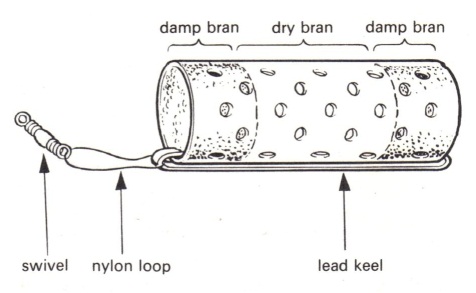
"Competition Sea Angling" (1970) Bruce McMillen at pages 46, 47, 59 & 60
4. Methods
Bait additives
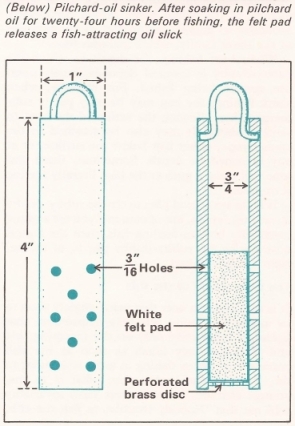
The competitive angler should improve his catches by using additives, such as pilchard oil, either on the bait or in its close proximity. These additives do quite definitely act as fish attractors and they have, in this respect, proved their true worth by helping me to win many competitive events.
In order to introduce, say, pilchard oil into the bait, various novel ideas have been successfully employed, these include hypodermic syringes, fountain pen fillers, oil cans and other similar devices. A small strip of felt coiled around the line just above the hook, will if soaked in the oil, gradually release a slick for quite a long period. When competition fishing I have had great success, particularly with codling, when using a sinker which I designed. It is hollowed out and has perforated sides. To save the trouble of boring a block of lead, ordinary lead piping can be used. Plug the hollow centre with felt or cotton wool - a substance which will hold a quantity of pilchard oil. The oil will gradually disperse in the region of the baited hooks. I can assure you that this idea really does work, just try it !
When buying pilchard oil always make sure that you are supplied with the 'full-strength' variety in order to gain the greatest advantage from using it.
'Rubby dubby' cubes containing pilchard oil are obtainable and each packet is accompanied by a number of small mesh nets for holding them. These cubes can be used in place of a casting weight, and in fact I have utilised them in this manner with very successful results when beach fishing for bass.
4. Species
Cod and codling
… The addition of an oil attractor, particularly pilchard oil, to the bait or by placing it in the near vicinity, quite definitely improves one's chances in competitive angling, and particularly so when fishing for cod. I strongly recommend the angler to use the pilchard oil sinker described (above).
PVA Bags
PVA stands for Polyvinyl Alcohol which has great film-forming and adhesive properties. It is resistant to oil, grease and solvents, has a high tensile strength and flexibility and is odourless and non-toxic.
To attract fish to your baited hook, attach a PVA bag filled with dry bait to the end tackle as close to the baited hook as the end tackle allows. Make sure the PVA bag is dry or it will melt before you get a chance to cast it. Fill the PVA bag with PVA friendly bait (this could be PVA-friendly dry ground bait e.g. dry gel caps filled with these six amino acids - betaine, glycine, alanine, proline, histidine and arginine. When the bag is full, use either PVA string or PVA tape to tie the bag shut by fastening it to the main line. Ensure that the PVA bag does not touch the water before casting.
It is also possible to encapsulate the entire rig inside the PVA bag before casting with the advantage that:
- it is more aerodynamic than casting a PVA bag hanging off a rig hook (as with a swimfeeder);
- presentation of the rig is much improved due to the hook, hook-bait and rig being protected until the PVA has melted;
- the hook-bait is enclosed by the contents of the PVA bag and not merely close by the rig.
PVA bags come in all shapes and sizes: large, small, mini and tubes (for longer distance casting). The warmer the water, the faster the PVA bags melt (and vice-versa) and there are now various types of PVA to cater for all conditions.
A recent development in PVA bag fishing is to load small PVA mesh bags very tightly with groundbait mixes and compress the bait inside the bag with a dedicated plunger. As the compressed mix begins to swell after casting it eventually bursts out of the bag and disperses down tide. Again, is it good practice for the bait and rig to be fished inside the PVA bag.
Always store PVA products in a dry environment. Oily baits can slow down the melt rate in cold conditions.

Fox Arma Mesh®
Another major step forward in PVA has been the introduction and development of mesh or stocking-type PVA which (1) allows water to pass through, within and around the PVA parcel and its contents and (2) speeds up the meltdown considerably. It is also very strong when dry and lends itself to knotting far more readily than the solid bags. Different gauges allow for different water conditions and different baits.
Acknowledged to be one of the biggest advancements in hook-bait systems, Arma Mesh® is available on 7m tubes with both narrow (14mm) and wide (22mm) diameter variants and fine and heavy weaves. It has a tough hexagonal weave, similar in appearance to PVA, but it is made from nylon and does not dissolve in water so, instead of using it to create a free offerings around and down tide of your hook-bait (as with PVA bags), Arma Mesh® is used to create actual hook-baits.
Arma Mesh® is supplied on a loading tube with a plunger allowing you to create unique bait combinations.
Arma Mesh® is also useful for protecting hook-baits from nuisance species and meshing pellet hook-baits will prolong their underwater life allowing you to fish them all day or night. Select the fine denier weave for most angling situations but step up to the double thickness heavy version where crabs are a real menace.
Arma Mesh® is supplied on a loading tube and baits are pushed through using the supplied plunger and tied off exactly like PVA to produce armoured baits - hence the name.
Angling Times testimonial
Fonderia Roma Roccotop Feeder
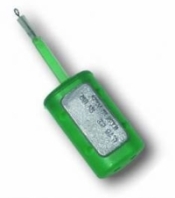
Weights: 100g, 125g and 150g
Price: £3.19 (rrp) but are available at £2.40 - 2.99
The unique plastic feeder can be unscrewed to add groundbait, oils or essences which have been soaked into a cotton wad or a sponge - see "Sea Angler" review below.
Fonderia Roma Feeder leads are designed for surfcasting and bottom fishing.
A saltwater swim feeder which can be used by filling with a sponge and adding attractants or by filling with groundbait.
The standard Fonderia Roma Feeder (see image to the right) comes in five sizes: 21, 35, 42, 65 and 80g
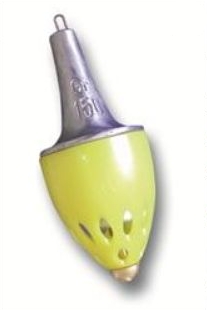
"Sea Angler" (Issue 505 May-June 2014) Paul Fenech at pages 42 & 43
At Long Last! A Feeder That Really Works
Paul Fenech discovers a new method to attract fish to your bait even when the bites dry up.
"What's that?" I asked. George (Cunningham) smiled and then began to unscrew the coloured bottom section of the sinker. It had the appearance of a capsule with vents all around it.
"It is a Fonderia Roma Roccotop Feeder and this part of the sinker is filled with groundbait. When it is cast out, the contents leak out slowly and hopefully attract lots of fish," said George.
The fact that it can actually be stuffed with chopped-up fish or other smelly offerings means it is a superb way to create an extra scent trail. Then George produced another item, this time in a bag. I'd seen one of these before, but only on my coarse fishing sessions.
This is a groundbait mix from Marukyu that Tronix will soon be distributing. Simply mix the contents with some water and fill the Roccotop Feeder with it. This is Sabiki Powder and it contains shiny particles that sight-feeding species will pick up on in clear water," said George.
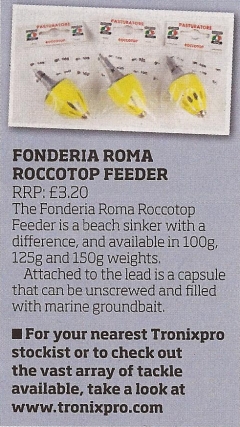 |
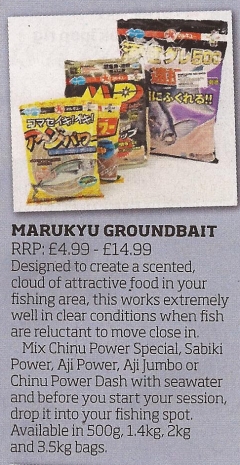 |
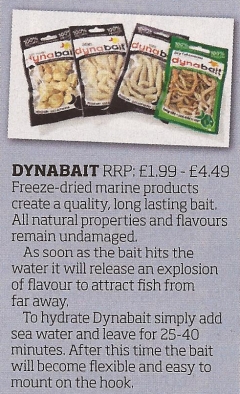 |
Once it was mixed it smelled totally fishy, and in the water it leaked out to form a cloud of attracting scent. I'd heard stories of anglers using devices like swimfeeders, or wrapping pieces of mackerel around sinkers and enjoying success. This was much better by a country mile. Of course, a strong running tide can, and probably will, carry the scent away from you but other than that, it will attract feeding fish close to your rig. It didn't stop there either. Out came a selection of preserved baits stored in containers. Their labels revealed that they contained ragworms, sandworms, peeled shrimps and mussels.
"Add a little water to these and give them time to re-hydrate," advised George.
Although these were highly scented, I've always been sceptical with this kind of bait. With nobody catching, I was intrigued to see the results.
… On a day when nobody seemed to be catching, the groundbait and preserved bait approach had worked from the first cast … Other anglers on the beach remained fishless, so it's possible that the groundbait offered in the Roccotop Feeder had pulled what fish were around in front of the pair. I reckon it did.
When shore fishing is tough and you can't buy a bite, try adding a little extra scent and you could be amazed at the results.
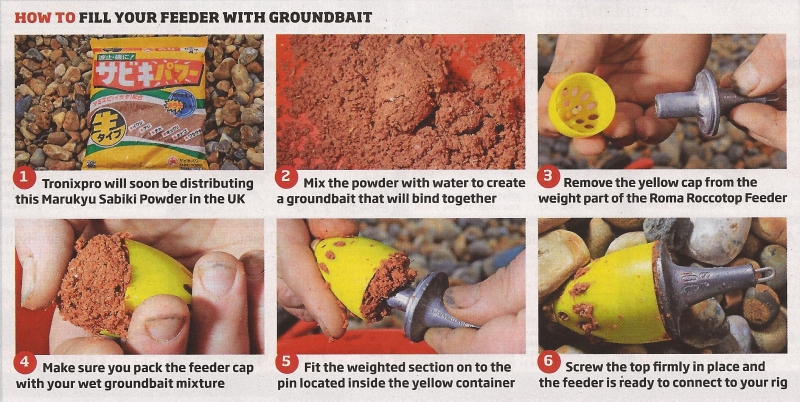
Delalande Surf Feeder
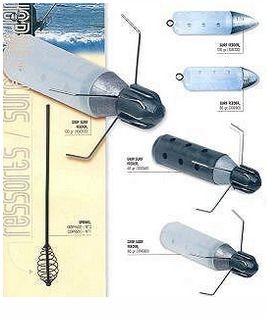
The Surf Feeder from Delalande is the answer to many anglers need for a robust method of enticing fish to where the baited hook is laying. Constructed from top quality materials, the Surf Feeder will withstand the rigours of fishing rough ground and, with the addition of the 'Grip' head from Gemini Tackle, the feeder can be used in virtually every sea state, on the beach or uptiding from a boat.
Whatever bait you are going to fish with, use some in your feeder; better still, don't chuck away yesterday's bait, take it home and use it in your feeder and it will pay for your feeder in a short period of time. Place the bait in a blender or mincer and reduce to a pulp. Place the pulp into the feeder capsule; refit to the main body, bag and freeze. Cast your feeder while still frozen and this method will give you about 35 minutes of steady scent trail. The Surf Feeder will hold approximately 30g of pulp.
Weights:
- Standard Feeder: 60g £2.15, 80g £2.35, 100g £2.40, 120g £2.45
- Grip Feeder 80g £2.40, 150g £2.95, 180g £3.15
- spare feeder capsule £1.00
Buy online from Sharnbrook Tackle
Mini Anchor Feeder
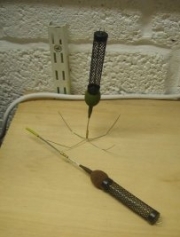
This range of mini anchor weight feeders has been specifically designed for the light-line angler in freshwater and tidal water uses. Manufactured using the finest sprung stainless steel wire for long life and the new process 'textured' coated weights, the Mini Anchor Feeders are a perfect accessory for fishing fast flowing rivers or rivers in flood and also estuaries and shore-line work for flounder, sole, bass etc without the need for heavy weights. Where traditionally a 3 oz to 5 oz watch weight might have been necessary, the Mini Anchor Feeder of ½ oz to 2 oz will be more than man enough for the job. You determine the type of grip configuration that you want.
- ½ oz £2.40, ¾ oz £2.60, 1 oz £2.80, 2 oz £3.15
- brown or green textured
Buy online from Sharnbrook Tackle
Chum Bob Float Feeder
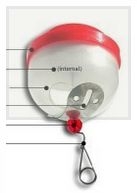
One of the most tried and trusted methods of catching fish is to attract them with chum which triggers both a visual and an olfactory response in fresh and salt-water fish of all types. No one to date has been able to successfully develop a product that would enable the fisherman to present chum in a time-released fashion directly within a designated fishing area and this method of fishing greatly increases the fisherman's odds of larger and more frequent hook-ups. For use with your own chopped bait and additives or use the free Chum provided with this model.
Total Price: £4.80
Buy online from Sharnbrook Tackle
Cage 'n' Juice Feeder
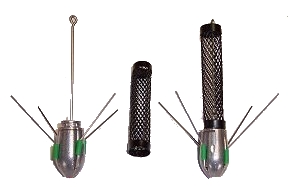
Streamlined and casts like a regular weight, it lays a massive scent trail on the seabed to attract fish to your baited hooks. Use a variety of very concentrated attractants and no need to use big baits - save money and cast further. Top quality "grip-away" 3, 4 and 5 oz leads and really tough coated metal cages designed to last. Dimensions:- cage 80 mm length, 15 mm diameter. Break-out lead 25 mm width, 40 mm length (approximately).
- 3 oz £3.30
- 4 oz £3.50
- 5 oz £3.70
- Spare cage £1.00
Buy online from Sharnbrook Tackle